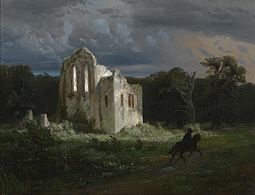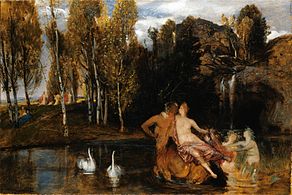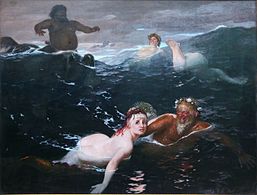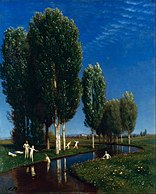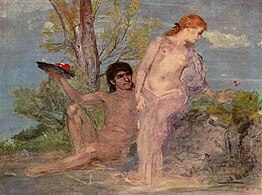.
Arnold Böcklin | |
|---|---|
 Self-portrait Oil on canvas (1872) | |
| Born | Arnold Böcklin 16 October 1827 Basel, Switzerland |
| Died | 16 January 1901 (aged 73) Fiesole, Italy |
| Nationality | Swiss |
| Known for | Painting |
Notable work | Isle of the Dead |
| Movement | Symbolism |
Arnold Böcklin (16 October 1827 – 16 January 1901) was a Swiss symbolist painter.
암울한 풍경화와 불길한 비유화 등을 그려 19세기 후반의 독일 미술가들에게 큰 영향을 미쳤으며 20세기의 형이상학파 및 초현실주의 화가들의 상징적 경향을 예고했다. 유럽 북부의 많은 지역을 돌아다니며 연구하고 작품 활동을 했지만, 이탈리아의 풍경에서 진정한 영감을 얻었다. 그는 이탈리아에 자주 드나들었으며 말년에는 그곳에서 지냈다.
대형 벽화인 〈수풀 속의 판 Pan in the Bulrushes〉(1857경, 뮌헨 노이에 피나코테크)으로 처음 명성을 얻었으며 바이에른 왕의 후원을 받게 되었다.
1858~61년 바이마르 미술학교에서 회화를 가르쳤지만 언제나 이탈리아의 풍경을 그리워했다. 바젤에 있는 공립미술관에 신화를 내용으로 한 프레스코를 완성한 뒤 이탈리아에 정착했으며 가끔씩 독일에 다녀오곤 했다. 마지막 20년 동안 그의 작품은 점점 주관적인 성향을 띠어 〈죽은 자들의 섬 Island of the Dead〉(1880, 뉴욕 메트로폴리탄 미술관)처럼 기괴한 생물들을 나타내거나 난해한 알레고리들을 다루었다. 러시아의 작곡가 세르게이 라흐마니노프는 이 작품에서 영감을 받아 교향시 〈죽음의 섬〉을 작곡했다.
그의 마지막 작품들 중 〈오디세우스와 칼립소 Odysseus and Calypso〉(1883, 바젤 공립미술관)·〈페스트 The Pest〉(1898, 바젤 공립미술관)와 같은 환상적인 그림들은 20세기 미술에 자주 등장하는 이른바 프로이트적 이미지를 예견하는 병적인 상징성을 드러내고 있다.[다음백과]
Biography
He was born in Basel. His father, Christian Frederick Böcklin (b. 1802), was descended from an old family of Schaffhausen, and engaged in the silk trade. His mother, Ursula Lippe, was a native of the same city.[1] Arnold studied at the Düsseldorf academy under Schirmer,[1] and became a friend of Anselm Feuerbach. He is associated with the Düsseldorf school of painting. Schirmer, who recognized in him a student of exceptional promise, sent him to Antwerp and Brussels, where he copied the works of Flemish and Dutch masters. Böcklin then went to Paris, worked at the Louvre, and painted several landscapes.[1]
After serving his time in the army, Böcklin set out for Rome in March 1850. In Rome, he married Angela Rosa Lorenza Pascucci in 1853. The many sights of Rome were a fresh stimulus to his mind. These new influences brought allegorical and mythological figures into his compositions. In 1856 he returned to Munich, and remained there for four years.
Career

He then exhibited the Great Park, one of his earliest works, in which he treated ancient mythology. Of this period are his Nymph and Satyr, Heroic Landscape (Diana Hunting), both of 1858, and Sappho (1859). These works, which were much discussed, together with Lenbach's recommendation, gained him appointment as professor at the Weimar academy. He held the office for two years, painting the Venus and Love, a Portrait of Lenbach, and a Saint Catherine.[1]
He returned to Rome from 1862 to 1866, and there gave his fancy and his taste for violent colour free play in his Portrait of Mme Böcklin, and in An Anchorite in the Wilderness (1863), a Roman Tavern, and Villa on the Seashore (1864). He returned to Basel in 1866 to finish his frescoes in the gallery, and to paint, besides several portraits, The Magdalene with Christ (1868), Anacreon's Muse (1869), and A Castle and Warriors (1871). His Portrait of Myself, with Death playing a violin (1872), was painted after his return again to Munich, where he exhibited Battle of the Centaurs, Landscape with Moorish Horsemen and A Farm (1875). From 1876 to 1885 Böcklin was working at Florence, and painted a Pietà, Ulysses and Calypso, Prometheus, and the Sacred Grove.[1]
From 1886 to 1892 he settled at Zürich. Of this period are the Naiads at Play, A Sea Idyll, and War. After 1892 Böcklin resided at San Domenico, near Florence.[1]
Böcklin died on 16 January 1901 in Fiesole. He is buried in the Cimitero degli Allori in the southern suburb of Florence, Italy.
Symbolism
Influenced by Romanticism his painting is symbolist with mythological subjects often overlapping with the Pre-Raphaelites. His pictures portray mythological, fantastical figures along classical architecture constructions (often revealing an obsession with death) creating a strange, fantasy world.
Böcklin is best known for his five versions (painted 1880 to 1886) of the Isle of the Dead, which partly evokes the English Cemetery, Florence, close to his studio and where his baby daughter Maria had been buried. An early version of the painting was commissioned by a Madame Berna, a widow who wanted a painting with a dream-like atmosphere.[2]
Clement Greenberg wrote in 1947 that Böcklin's work "is one of the most consummate expressions of all that was now disliked about the latter half of the nineteenth century."[3]
Legacy
Böcklin exercised an influence on Giorgio de Chirico,[4] and on Surrealist painters like Max Ernst and Salvador Dalí. When asked who was his favorite painter, Marcel Duchamp controversially named Arnold Böcklin as having a major influence on his art. Whether Duchamp was serious in this assertion is still debated.
H. R. Giger has a picture called Hommage to Boecklin, based upon Isle of the Dead.
Several of his works are part of the collection of the Kunstmuseum Basel and exhibited there. There is currently also a room in the Kunsthaus Zürich dedicated to his work.
In music[edit]
Böcklin's paintings, especially Isle of the Dead, inspired several late-Romantic composers.
- Gustav Mahler's song Des Antonius von Padua Fischpredigt (St. Anthony's Sermon to the Fish) from his Des Knaben Wunderhorn song cycle, which also appears as the Scherzo movement in Mahler's Symphony No. 2 (Mahler) was inspired by Böcklin's 1892 painting, St. Anthony Preaching to the Fish.
- Sergei Rachmaninoff (see Isle of the Dead) and Heinrich Schulz-Beuthen both composed symphonic poems after it. Rachmaninoff was also inspired by Böcklin's painting Die Heimkehr ("The Homecoming" or "The Return") when writing his Prelude in B minor, Op. 32, No. 10.[5][6]
- Andreas Hallén, a Swedish Romantic composer, wrote a symphonic poem Die Toteninsel in 1898.
- In 1913 Max Reger composed a set of Four Tone Poems after Böcklin with the movements "Der geigende Eremit", "Im Spiel der Wellen", "Die Toteninsel", and "Bacchanal".
- In Mark Robson's film Isle of the Dead (1945), Disney composer Leigh Harline's somber score makes use of Sergei Rachmaninoff's music.
- Hans Huber's second symphony is entitled Böcklin-Sinfonie, after the artist and his paintings.
- Felix Woyrsch composed 3 Böcklin Phantasies (Die Toteninsel, Der Eremit, Im Spiel der Wellen), Op. 53 (1910).
Other
Otto Weisert designed an Art Nouveau typeface in 1904 and named it "Arnold Böcklin" in his honor.
Adolf Hitler was fond of Böcklin's work, at one time owning 11 of his paintings.[7]
Roger Zelazny titled one of his novels Isle of the Dead after Böcklin's paintings, and an Ace books
edition featured a cover painting by Dean Ellis that was deliberately reminiscent of Böcklin's work.[8]
Works
'♣ 미술(美術) 마당 ♣ > - 화가[畵家]' 카테고리의 다른 글
| [프랑스 풍경화가]조제프 베르네 [Claude Joseph Vernet ] (0) | 2019.05.25 |
|---|---|
| [미국 - 허드슨 강파를 창시한 낭만파 풍경화가] Thomas Cole (0) | 2019.05.11 |
| [이탈리아- 상징주의 화가]Gaetano Previati (0) | 2019.05.07 |
| [영국]George Romney (0) | 2019.04.30 |
| [슈만, 리스트 등의 초상화를 그린 화가]Josef Kriehuber[요제프 크리후버] (0) | 2019.04.21 |




